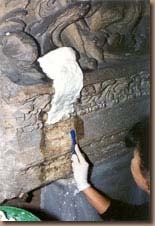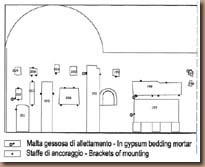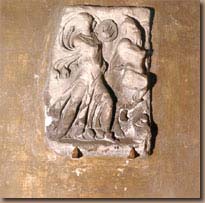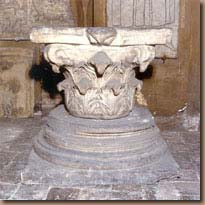Treatment
Different operations have been proposed according to the different conditions and positions of the fragments.
The cleaning tests carried out have confirmed the validity of using poultices with special clays whose intrinsic properties enable them to absorb large quantities of water through its solvent and softening capacity. In particular, sepiolite was used for the tests, which thanks to its molecular structure, manages to absorb about 1.5 kg of water for every kilogram of powder without altering its volume.
The lapidary surfaces tested were first of all degreased with the aim of making them permeable. Then the sepiolite dissolved in de-ionized water was applied on a stratum of about 2 cm thick. Given the diverse nature of the deposits, it was from time to time considered opportune to adopt differential times of application after which the surfaces were washed copiously. In cases where black crusts were particularly thick a double poultice application was necessary as well as the use of small mechanical brushes to remove the more resilient deposits and concretions. (RA 191 and 195).
Because of the long periods that the poultices have to be applied, it is first of all necessary to treat the surfaces with biocides several days before the poultice treatment to avoid the recurrence of, apparently placated, biological attacks.
In the case of the cloister, this type of cleaning, though excellent, is difficult to apply to the fragments fixed to the walls of the corridors with gypsum based mortar. Gypsum, as is known, is characteristically unstable in the presence of water and poultice cleaning followed by washing, despite taking care to seal off edges, runs the risk of water reaching the gypsum mortar to the detriment of the fragment and its conservation. The removal and replacement of this mortar, used profusely in the cloister, would also result in having to remove a large number of the exhibits, drastically altering their present unity, a policy that without doubt must be excluded from the plan of general principles adopted to guarantee the safeguard of the, also material, authenticity of the complex.
For this reason the necessity to clean the fragments fixed to the wall without removing them involves the adoption of two different cleaning methods: ‘laser’ for those built in with gypsum mortar and ‘poultices’ for all the others. The characteristics of laser cleaning have been illustrated in the report on stone materials.
The case of the south wall, as with the conservation project for the intonaco surfaces, must be considered apart. Its degree of decay is extreme and the gypsum based mortar and bracket supports are in a dire state of conservation. For this side and for an isolated case on the west side it has therefore been decided to remove a number of the fragments that will be remounted with suitable mortar and with new stainless steel brackets, after completing the necessary treatment for the underlying walls.
With regard to the presence of residues of ‘historical’ mortars on the fragments, their removal will be assessed case by case, which will however be accurately recorded during the course of operations. Research will be done, for example, to see whether the mortar pertains to that of the cosmatesque pavement of the basilica, in order to reconstruct the provenance of certain pieces so far not fully documented.
All the gypsum based or cement fillings that disturb the legibility of the fragment will be removed. They will be replaced with a pre-established lime, pozzolana and sand based mortar that has been tested for both its mechanical properties and its grain size and color. With regard to the fragments in direct contact with the pavement, a removable support of minimal proportions will be inserted beneath, isolating them from rising damp and improving the distribution of the load on the pavement.
The proposed treatments are as follows:
Preventive treatment with biocides (preventol) to be carried out several times at intervals some days before continuing any further treatment.
Removal a secco of surface deposits using brushes and compressed air at low pressure.
Temporary filling and micro-filling in cases at risk in order to facilitate subsequent cleaning operations.
Removal of iron oxide stains from the stone surface, produced by the brackets supporting the fragments.
-
Laser cleaning of fragments attached to the walls with gypsum based mortar.
Cleaning with poultices of sepiolite powder in distilled water or with ammonium carbonate pulp poultices, according to the thickness of the deposits, of the moveable fragments and those attached to the wall with traditional mortars. The finishing phase with micro-drills and scalpels will be carried out during and following the above operation.
Removal, cleaning, consolidation and storing of 17 fragments from the south side and one from the west side. These pieces will be cleaned with ammonium carbonate pulp poultices and re-mounted in the same position with stainless steel brackets on completion of the treatment to the walls.
Micro-fillings in cases of micro-fractures of the lapidary material, carried out with a mortar of slaked lime and marble dust, previously tested to ensure its suitability both in grain size and color.
Repair and consolidation of the fillings surrounding the fragments taking the difference in materials into account: the gypsum fillings will be re-integrated with a specially tested mortar compatible with the existing one; a lime and red pozzolana based mortar will instead be used for the traditional fillings. Their respective consolidation will be carried out with resin injections for the former and pre-mixed hydraulic mortar injections for the latter.
Control of the functional capacity of the attachment brackets, treatment for the removal of oxides and subsequent painting with an appropriate product.
Application of ethyl silicate by brush up to saturation point in order to consolidate the areas where phenomena of disintegration are present.
Final surface treatment with silicon resin to protect the treated surfaces.
|
© 1999 Coordination
Monica Morbidelli |



